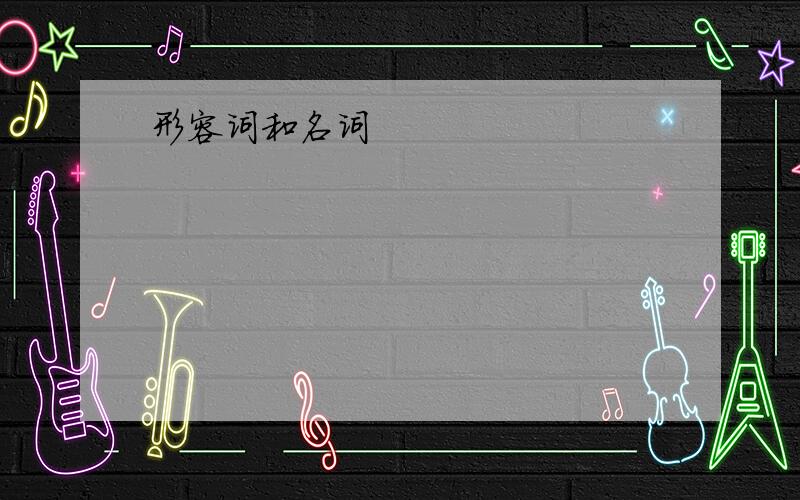形容词和名词
来源:学生作业帮 编辑:搜搜考试网作业帮 分类:英语作业 时间:2024/07/12 13:58:22
形容词和名词分别在什么时候用? 解答希望清楚些 谢谢老师

解题思路: 知识点的总结。
解题过程:
一、名词的用法
1.单数和复数
可数名词有单数和复数两种形式。复数形式通常是在单数形式后加词尾“-s”构成,其主要变法如下:
(1)一般情况在词尾加-s,例如:book→books,girl→girls,boy→boys,pen→pens,doctor→doctors, boy→boys。
(2)以s,x,ch,sh,结尾的词加-es,例如:bus→buses,class→classes,box→boxes,watch→watches,brush→brushes。
(3)以ce, se, ze,(d)ge结尾的名词加s,例如:orange—oranges。
(4)以辅音母加y结尾的词变“y”为“i”再加-es,例如:city→cities, factory→factories, country→countries, family→families。但要注意的是以元音字母加y结尾的名词的复数形式只加s,如:boy→boys, day→days。
(5)以o结尾的词多数都加-es。例如:hero→heroes,potato→potatoes,tomato→tomatoes,但词末为两个元音字母的词只加-s。例如:zoo→zoos,radio→radios,还有某些外来词也只加-s,例如:photo→photos,piano→pianos。
(6)以f或fe结尾的词,多数变f为v再加-es,例如:knife→knives,leaf→leaves, half→halves。
复数词尾s(或es)的读音方法如下表所示。
复数词尾s(或es)的读音方法
情 况 读法 例 词
在[p][t][k][f]等清辅音后 [s] cups, hats, cakes
在[s][z][t][ ][F]等音后
[iz] glasses, pages, oranges, buses, watches,faces
在[b][d][ ][v]等浊辅音后
[z] beds, dogs, cities, knives
(7)少数名词有不规则的复数形式,例如:man→men,woman→women,tooth→teeth,foot→feet,child→children,mouse→mice。
【注意】与man和woman构成的合成词,其复数形式也是-men和-women。例如:an Englishman,two Englishmen。但German不是合成词,故复数形式为 Germans;man, woman等作定语时,它的单复数以其所修饰的名词的单复数而定,如:men workers, women teachers。
有个别名词单复数一样,例如:Chinese,Japanese,sheep,deer,fish等。但当fish表示不同种类的鱼时,可以加复数词尾。
(8)单数形式但其意为复数的名词有:people, police等。
(9)数词+名词作定语时,这个名词一般保留单数形式,中间加连字符。例如:ten-minutes’ walk, an 8-year-old girl, a ten-mile walk。
(10)还有些名词仅有复数形式,如:trousers,clothes,chopsticks,glasses,goods,ashes,scissors,compasses。
(11)只用作单数的复数形式的名词有:
科学名词:physics, mathematics/maths
游戏名称:bowls
专有名词:the United States, Niagara Falls
其他名词:news, falls
2.不可数名词“量”的表示方法
在英语中,不可数名词如果要表示“量”的概念,可以用以下两种方法:
(1)用much, a little, a lot of/lots of, some, any等表示多少,例如:
The rich man has a lot of money.
There is some milk in the bottle.
Is there any water in the glass?
I don't like winter because there's too much snow and ice.
(2)用a piece of 这类定语,例如:
a piece of paper a piece of wood a piece of bread
a bottle of orange a glass of water(milk) a cup of tea
a cup of tea a bag of rice three bags of rice
如果要表示“两杯茶”、“四张纸”这类概念时,在容器后加复数,例如:
two cups of tea
four pieces of paper
three glasses of water
不可数名词也可用a lot of, lots of, some, any, much等来修饰。
二、名词的所有格
名词所有格,用来表示人或物的所有,以及领属关系。
1. 表示有生命的名词的所有格其单数形式是加 's,其复数形式是s',例如:a student's room, students' rooms, father's shoes。
2. 如其结尾不是s的复数形式仍加 's,如:Children's Day。
3. 在表示时间、距离、长度、重量、价格、世界、国家等名词的所有格要用 's,例如:a twenty minutes' walk,ten miles' journey,a boat's length,two pounds' weight,
4. 无生命名词的所有格则必须用of结构,例如:a map of China,the end of this term,the capital of our country, the color of the flowers。
5. 双重所有格,例如:a friend of my father's。
【注意】
如果两个名词并列,并且分别有 's,则表示“分别有”,例如:John's and Mary's rooms(约翰和玛丽各有一间,共两间);Tom's and Mary's bikes(两人各自的自行车)。
两个名词并列,只有一个's,则表示“共有”,例如:John and Mary's room(约翰和玛丽共有一间);Tom and Mary's mother(即Tom与Mary是兄妹)。
形 容 词 的 定 义 和 用 法:
形容词用来修饰名词或代词, 表示人或事物的性质, 状态,和特征。
形容词在句中作定语, 表语, 宾语,补语。
She is a good student, and she works hard.
她是一个好学生,她学习努力。
This bike is expensive.
这辆自行车很贵。
I am sorry, I'm busy now.
对不起,我现在很忙。
Have you got everything ready for the meeting?
你为这次会议做好准备吗?
形容词在句中的位置
形容词作定语一般放在被修饰的名词之前。如果有两个或两个以上的形容词修饰一个名词时, 则由它们和被修饰的名词之间的密切程度而定, 越密切的形容词越靠近名词。如果几个形容词的密切程度差不多则按音节少的形容词放在前面, 音节多的形容词放在后面。
英语单词中,something, anything, nothing 等不定代词被形容词修饰时,形容词放在名词后面。
I have something important to tell you.
我有重要的事要告诉你。
Is there anything interesting in the film.
电影里有什么有趣的内容吗?
There is nothing dangerous here.
这儿一点都不危险。
由两个或两个以上的词组成的形容词词组修饰名词时须放在名词之后
This is the book easy to read.
这是一本容易读的书。
用 and 或 or 连接起来的两个形容词作定语时一般把它们放在被修饰的名词后面。起进一步解释的作用。
Everybody, man and woman, old and young, should attend the meeting.
每一个人,男女老少,都应该参加会议。
最终答案:略
解题过程:
一、名词的用法
1.单数和复数
可数名词有单数和复数两种形式。复数形式通常是在单数形式后加词尾“-s”构成,其主要变法如下:
(1)一般情况在词尾加-s,例如:book→books,girl→girls,boy→boys,pen→pens,doctor→doctors, boy→boys。
(2)以s,x,ch,sh,结尾的词加-es,例如:bus→buses,class→classes,box→boxes,watch→watches,brush→brushes。
(3)以ce, se, ze,(d)ge结尾的名词加s,例如:orange—oranges。
(4)以辅音母加y结尾的词变“y”为“i”再加-es,例如:city→cities, factory→factories, country→countries, family→families。但要注意的是以元音字母加y结尾的名词的复数形式只加s,如:boy→boys, day→days。
(5)以o结尾的词多数都加-es。例如:hero→heroes,potato→potatoes,tomato→tomatoes,但词末为两个元音字母的词只加-s。例如:zoo→zoos,radio→radios,还有某些外来词也只加-s,例如:photo→photos,piano→pianos。
(6)以f或fe结尾的词,多数变f为v再加-es,例如:knife→knives,leaf→leaves, half→halves。
复数词尾s(或es)的读音方法如下表所示。
复数词尾s(或es)的读音方法
情 况 读法 例 词
在[p][t][k][f]等清辅音后 [s] cups, hats, cakes
在[s][z][t][ ][F]等音后
[iz] glasses, pages, oranges, buses, watches,faces
在[b][d][ ][v]等浊辅音后
[z] beds, dogs, cities, knives
(7)少数名词有不规则的复数形式,例如:man→men,woman→women,tooth→teeth,foot→feet,child→children,mouse→mice。
【注意】与man和woman构成的合成词,其复数形式也是-men和-women。例如:an Englishman,two Englishmen。但German不是合成词,故复数形式为 Germans;man, woman等作定语时,它的单复数以其所修饰的名词的单复数而定,如:men workers, women teachers。
有个别名词单复数一样,例如:Chinese,Japanese,sheep,deer,fish等。但当fish表示不同种类的鱼时,可以加复数词尾。
(8)单数形式但其意为复数的名词有:people, police等。
(9)数词+名词作定语时,这个名词一般保留单数形式,中间加连字符。例如:ten-minutes’ walk, an 8-year-old girl, a ten-mile walk。
(10)还有些名词仅有复数形式,如:trousers,clothes,chopsticks,glasses,goods,ashes,scissors,compasses。
(11)只用作单数的复数形式的名词有:
科学名词:physics, mathematics/maths
游戏名称:bowls
专有名词:the United States, Niagara Falls
其他名词:news, falls
2.不可数名词“量”的表示方法
在英语中,不可数名词如果要表示“量”的概念,可以用以下两种方法:
(1)用much, a little, a lot of/lots of, some, any等表示多少,例如:
The rich man has a lot of money.
There is some milk in the bottle.
Is there any water in the glass?
I don't like winter because there's too much snow and ice.
(2)用a piece of 这类定语,例如:
a piece of paper a piece of wood a piece of bread
a bottle of orange a glass of water(milk) a cup of tea
a cup of tea a bag of rice three bags of rice
如果要表示“两杯茶”、“四张纸”这类概念时,在容器后加复数,例如:
two cups of tea
four pieces of paper
three glasses of water
不可数名词也可用a lot of, lots of, some, any, much等来修饰。
二、名词的所有格
名词所有格,用来表示人或物的所有,以及领属关系。
1. 表示有生命的名词的所有格其单数形式是加 's,其复数形式是s',例如:a student's room, students' rooms, father's shoes。
2. 如其结尾不是s的复数形式仍加 's,如:Children's Day。
3. 在表示时间、距离、长度、重量、价格、世界、国家等名词的所有格要用 's,例如:a twenty minutes' walk,ten miles' journey,a boat's length,two pounds' weight,
4. 无生命名词的所有格则必须用of结构,例如:a map of China,the end of this term,the capital of our country, the color of the flowers。
5. 双重所有格,例如:a friend of my father's。
【注意】
如果两个名词并列,并且分别有 's,则表示“分别有”,例如:John's and Mary's rooms(约翰和玛丽各有一间,共两间);Tom's and Mary's bikes(两人各自的自行车)。
两个名词并列,只有一个's,则表示“共有”,例如:John and Mary's room(约翰和玛丽共有一间);Tom and Mary's mother(即Tom与Mary是兄妹)。
形 容 词 的 定 义 和 用 法:
形容词用来修饰名词或代词, 表示人或事物的性质, 状态,和特征。
形容词在句中作定语, 表语, 宾语,补语。
She is a good student, and she works hard.
她是一个好学生,她学习努力。
This bike is expensive.
这辆自行车很贵。
I am sorry, I'm busy now.
对不起,我现在很忙。
Have you got everything ready for the meeting?
你为这次会议做好准备吗?
形容词在句中的位置
形容词作定语一般放在被修饰的名词之前。如果有两个或两个以上的形容词修饰一个名词时, 则由它们和被修饰的名词之间的密切程度而定, 越密切的形容词越靠近名词。如果几个形容词的密切程度差不多则按音节少的形容词放在前面, 音节多的形容词放在后面。
英语单词中,something, anything, nothing 等不定代词被形容词修饰时,形容词放在名词后面。
I have something important to tell you.
我有重要的事要告诉你。
Is there anything interesting in the film.
电影里有什么有趣的内容吗?
There is nothing dangerous here.
这儿一点都不危险。
由两个或两个以上的词组成的形容词词组修饰名词时须放在名词之后
This is the book easy to read.
这是一本容易读的书。
用 and 或 or 连接起来的两个形容词作定语时一般把它们放在被修饰的名词后面。起进一步解释的作用。
Everybody, man and woman, old and young, should attend the meeting.
每一个人,男女老少,都应该参加会议。
最终答案:略